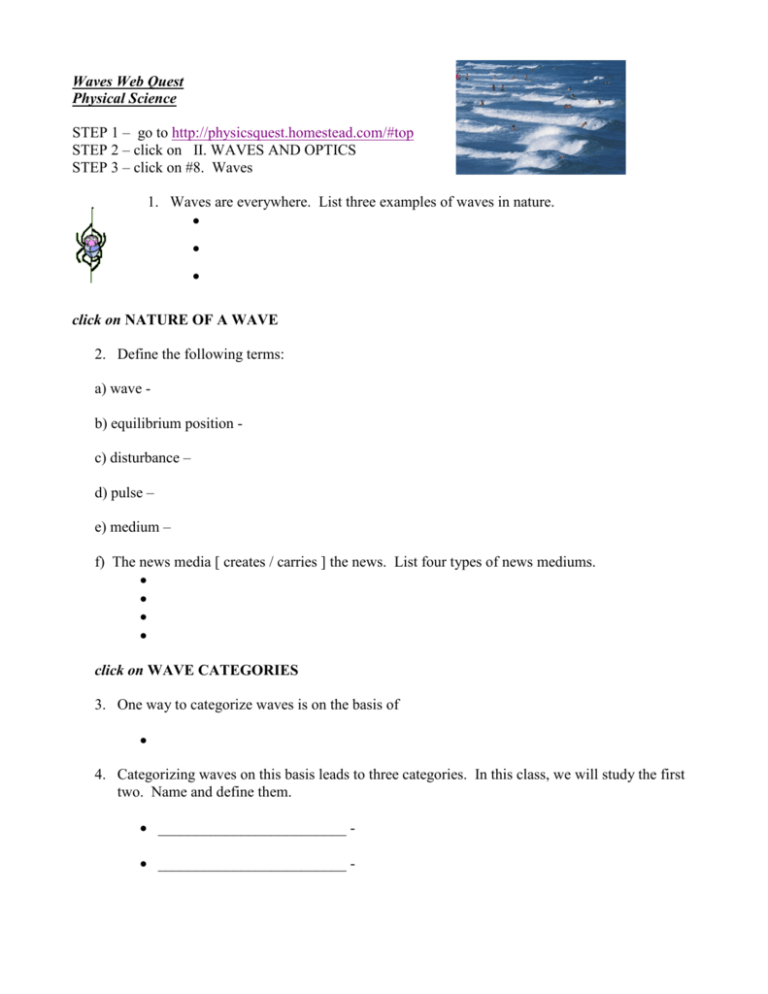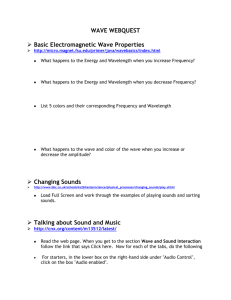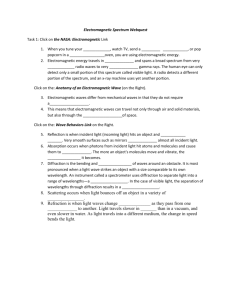Waves Web Quest - Fulton County Schools
advertisement

Waves Web Quest Physical Science STEP 1 – go to http://physicsquest.homestead.com/#top STEP 2 – click on II. WAVES AND OPTICS STEP 3 – click on #8. Waves 1. Waves are everywhere. List three examples of waves in nature. • • • click on NATURE OF A WAVE 2. Define the following terms: a) wave b) equilibrium position c) disturbance – d) pulse – e) medium – f) The news media [ creates / carries ] the news. List four types of news mediums. • • • • click on WAVE CATEGORIES 3. One way to categorize waves is on the basis of • 4. Categorizing waves on this basis leads to three categories. In this class, we will study the first two. Name and define them. • _________________________ • _________________________ - 5. Another way to categorize waves is on the basis of the ability to transmit energy through a vacuum. Categorizing waves on this basis leads to two categories. Name and define them. • _____________________________ • _____________________________ 6. Give three examples for each wave category listed in Question #5. • • click on LONGITUDINAL WAVES AND GUITAR STRINGS 7. A sound wave is produced by a ______________________ object. 8. Define compressions. 9. Define rarefactions. 10. An alternating pattern of compressions and rarefactions is known as a ______________________ _____________. 11. What benefit is there to attaching guitar strings to a wooden guitar body? • click on BEHAVIOR OF WAVES 12. Define boundary behavior:___________________________________________________ _________________________________________________________________________ 13. What happens to a pulse when it reaches a fixed end boundary? _____________________ _________________________________________________________________________ go to NEW SITE: http://hyperphysics.phy-astr.gsu.edu/hbase/hframe.html click on Light and Vision click on Propagation of Light click on electromagnetic spectrum click on any part of the electromagnetic spectrum for further detail 1) Choose a specific wavelength of visible light, a radio wave, and an x-ray to fill in the chart below. Remember your units! Type of radiation Wavelength Frequency Wave Speed Use http://imagine.gsfc.nasa.gov/docs/science/know_l1/emspectrum.html for questions 2-5 2) What do all types of electromagnetic radiation have in common? 3) What is different about the different parts of the electromagnetic spectrum? 4) Which type of radiation has the most energy? How or where is this radiation formed? 5) Raphael refers to a wave by noting its wavelength. Lucinda refers to a wave by noting its frequency. Which student is correct and why? Take the tour at http://imagers.gsfc.nasa.gov/ems/waves3.html and answer questions 6-11 6) How does the energy of the different waves of the spectrum vary with frequency? With wavelength? 7) What is the frequency range of UV light? Of Infrared light? 8) If you are use night-vision goggles, what part of the spectrum are you detecting? 9) Rich says that light is the same thing as electromagnetic radiation. Do you agree or disagree with Rich? Explain your response. 10) Do all animals see the same frequencies of “visible” light as humans do? Do all animals hear the same frequencies of sound as humans do? 11) Why do astronomers use frequencies other than the visible ones when they are investigating the universe? For Extra Credit, answer questions 12-14: Use http://www.qrg.northwestern.edu/projects/vss/docs/thermal/3-what-makes-emradiation.html to answer the following (the general site http://www.qrg.northwestern.edu/projects/vss/docs/Communications/2-more-about-radiowaves.html can also be used on other questions) 12) Why do materials absorb some frequencies of electromagnetic radiation and not others? 13) Why do waves with frequencies higher than visible light hurt us while those with lower frequencies do not affect us? 14) Light is sometimes described as a wave and sometimes as a particle. Give evidence to support the wave nature of light.







